一种新的随机梯度下降可能性聚类算法
IF 1
4区 计算机科学
Q4 COMPUTER SCIENCE, ARTIFICIAL INTELLIGENCE
引用次数: 4
摘要
为了有效地处理大数据问题,以及数据以流方式可用的情况,几个著名的聚类算法都有自己的在线对应项。然而,它们很少遵循随机梯度下降理论,尽管后者具有一定的实际优势(例如:(a)比批处理的同行运行得更快,(b)摆脱相关成本函数的局部极小值的可能性),此外,它已经建立了很强的理论收敛结果。本文介绍了一种新的随机梯度下降概率聚类算法O- pcm2。根据随机梯度下降算法族的一般收敛结果,详细地介绍了该算法,并严格地证明了相关代价函数的梯度在l2意义下趋于零。此外,对算法可能收敛的点的性质进行了额外的讨论。最后,在合成数据集和真实数据集的基础上,与其他相关算法进行了性能测试。本文章由计算机程序翻译,如有差异,请以英文原文为准。
A new stochastic gradient descent possibilistic clustering algorithm
Several well known clustering algorithms have their own online counterparts, in order to deal effectively with the big data issue, as well as with the case where the data become available in a streaming fashion. However, very few of them follow the stochastic gradient descent philosophy, despite the fact that the latter enjoys certain practical advantages (such as the possibility of (a) running faster than their batch processing counterparts and (b) escaping from local minima of the associated cost function), while, in addition, strong theoretical convergence results have been established for it. In this paper a novel stochastic gradient descent possibilistic clustering algorithm, called O- PCM 2 is introduced. The algorithm is presented in detail and it is rigorously proved that the gradient of the associated cost function tends to zero in the L 2 sense, based on general convergence results established for the family of the stochastic gradient descent algorithms. Furthermore, an additional discussion is provided on the nature of the points where the algorithm may converge. Finally, the performance of the proposed algorithm is tested against other related algorithms, on the basis of both synthetic and real data sets.
求助全文
通过发布文献求助,成功后即可免费获取论文全文。
去求助
来源期刊

AI Communications
工程技术-计算机:人工智能
CiteScore
2.30
自引率
12.50%
发文量
34
审稿时长
4.5 months
期刊介绍:
AI Communications is a journal on artificial intelligence (AI) which has a close relationship to EurAI (European Association for Artificial Intelligence, formerly ECCAI). It covers the whole AI community: Scientific institutions as well as commercial and industrial companies.
AI Communications aims to enhance contacts and information exchange between AI researchers and developers, and to provide supranational information to those concerned with AI and advanced information processing. AI Communications publishes refereed articles concerning scientific and technical AI procedures, provided they are of sufficient interest to a large readership of both scientific and practical background. In addition it contains high-level background material, both at the technical level as well as the level of opinions, policies and news.
 求助内容:
求助内容: 应助结果提醒方式:
应助结果提醒方式:


